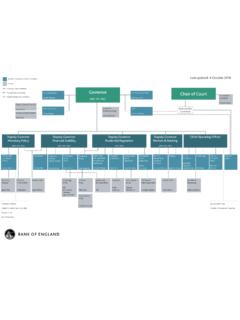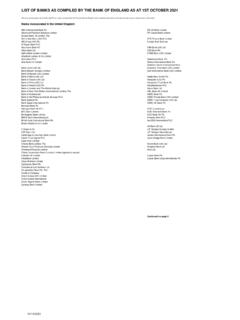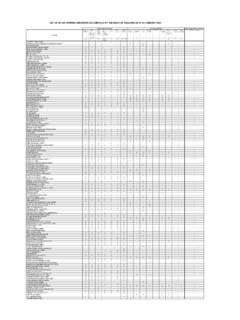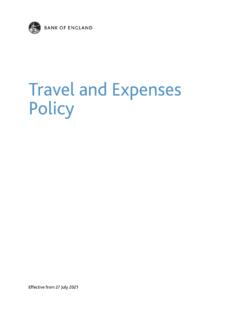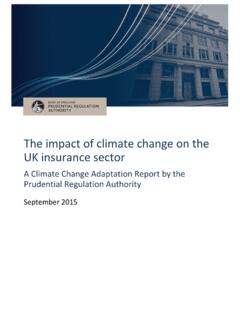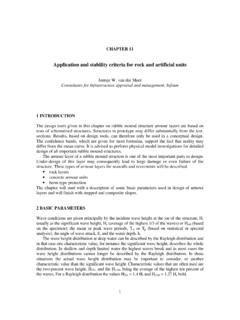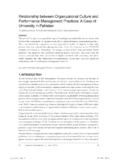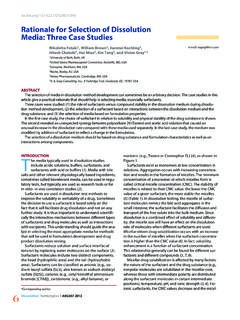Transcription of Financial Stability Report - Bank of England
1 Financial Stability ReportNovember 2017 | Issue No. 42 Presented to Parliament pursuant to Section 9W(10) of the Bank of England Act 1998 as amended by the Financial Services Act 2017 Financial Stability Report Bank of England 2017 ISSN 1751-7044 The primary responsibility of the Financial Policy Committee (FPC), a committee of the Bank of England , is to contribute to the Bank of England s objective for maintaining Financial Stability . It does this primarily by identifying, monitoring and taking action to remove or reduce systemic risks, with a view to protecting and enhancing the resilience of the UK Financial system.
2 Subject to that, it supports the economic policy of Her Majesty s Government, including its objectives for growth and employment. This Financial Stability Report sets out the FPC s view of the outlook for UK Financial Stability , including its assessment of the resilience of the UK Financial system and the current main risks to Financial Stability , and the action it is taking to remove or reduce those risks. It also reports on the activities of the Committee over the reporting period and on the extent to which the Committee s previous policy actions have succeeded in meeting the Committee s objectives.
3 The Report meets the requirement set out in legislation for the Committee to prepare and publish a Financial Stability Report twice per calendar addition, the Committee has a number of duties, under the Bank of England Act 1998. In exercising certain powers under this Act, the Committee is required to set out an explanation of its reasons for deciding to use its powers in the way they are being exercised and why it considers that to be compatible with its duties. The Financial Policy Committee:Mark Carney, GovernorJon Cunliffe, Deputy Governor responsible for Financial stabilityBen Broadbent, Deputy Governor responsible for monetary policyDave Ramsden, Deputy Governor responsible for markets and bankingSam Woods, Deputy Governor responsible for prudential regulationAlex Brazier, Executive Director for Financial Stability Strategy and RiskAnil KashyapDonald KohnRichard SharpMartin TaylorAndrew Bailey.
4 Chief Executive of the Financial Conduct AuthorityCharles Roxburgh attends as the Treasury member in a non-voting document was delivered to the printers on 27 November 2017 and, unless otherwise stated, uses data available as at 17 November 2017. This page was revised on 11 April Financial Stability Report is available in PDF at Stability ReportNovember 2017 | Issue No. 42 ForewordExecutive summary iPart A: Main risks to Financial Stability Overview of risks to UK Financial Stability and UK countercyclical capital buffer 1 Risks to the provision of Financial services from Brexit 8UK household indebtedness 13 Box 1 Survey measures of household vulnerability 19UK external financing 21 Asset valuations 25 Box 2 Risks from leveraged loans 30 Global debt vulnerabilities 32 Part B.
5 Resilience of the UK Financial system Banking sector resilience 35 Box 3 Results of the 2017 annual cyclical scenario 41 Box 4 IFRS 9 42 Market-based finance 43 Box 5 Developments in fast markets 49 Financial Stability risk and regulation beyond the core banking sector 52 The FPC s assessment of post-crisis reforms to derivatives markets 57 Box 6 UK authorities analysis of trade repository data 63 Annex 1: Previous macroprudential policy decisions 64 Annex 2: Core indicators 66 Index of charts and tables 70 Glossary and other information 72 Contents Executive summary iExecutive summary The Financial Policy Committee (FPC) aims to ensure the UK Financial system is resilient to, and prepared for, the wide range of risks it could face so that the system could support the real economy, even in difficult conditions.
6 The 2017 stress test shows the UK banking system is resilient to deep simultaneous recessions in the UK and global economies, large falls in asset prices and a separate stress of misconduct costs. The economic scenario in the test is more severe than the global Financial crisis. In the test, banks incur losses of around 50 billion in the first two years of the stress. This scale of loss, relative to their assets, would have wiped out the common equity capital base of the UK banking system ten years ago. The stress test shows these losses can now be absorbed within the buffers of capital banks have on top of their minimum requirements.
7 Major UK banks capital strength has tripled since 2007; their Tier 1 capital ratio was in aggregate in September 2017. For the first time since the Bank of England launched its stress tests in 2014, no bank needs to strengthen its capital position as a result of the stress FPC is raising the UK countercyclical capital buffer rate from to 1%, with binding effect from 28 November 2018. This will establish a system-wide UK countercyclical capital buffer of billion. Capital buffers for individual banks ( PRA buffers ) will be set by the Prudential Regulation Committee (PRC) in light of the stress-test results.
8 These will in part reflect the judgement made by the FPC and PRC in September 2017 that, following recent rapid growth, the loss rate on consumer credit in the first three years of the scenario would be 20%. The setting of the countercyclical and PRA buffers, as informed by the stress test, will not require banks to strengthen their capital positions. It will require them to incorporate some of the capital they currently have in excess of their regulatory requirements into their regulatory capital buffers. The purpose of these buffers is to be drawn on as necessary to allow banks to support the real economy in a stress-test scenario and the resulting setting of capital buffers reflect the FPC s assessment that, apart from those related to Brexit, domestic risks are at a standard level overall, and that risks from global debt levels, asset valuations and misconduct costs remain material.
9 There are also potential risks arising from the macroeconomic consequences of some possible Brexit outcomes. There are many possible combinations of risks that could result from a sudden exit from the European Union without a trade agreement. The outcome would depend on many factors, including the extent of contingency planning and government policies in the United Kingdom and European Union. ii Financial Stability Report November 2017 In the stress scenario, there is a sudden reduction in investor appetite for UK assets and the sterling exchange rate falls to its lowest ever level against the dollar.
10 Bank Rate rises to 4% and unemployment rises by more than in the Financial crisis. UK commercial property prices fall by 40%, and UK residential property prices fall by 33% the largest fall on record. The stress-test scenario therefore encompasses a wide range of UK macroeconomic risks that could be associated with Brexit. As a result, the FPC judges the UK banking system could continue to support the real economy through a disorderly Brexit. However, the combination of a disorderly Brexit and a severe global recession and stressed misconduct costs could result in more severe conditions than in the stress test.
